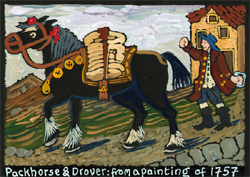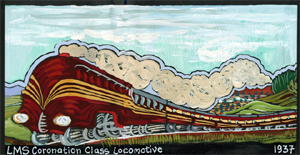
In the 1840's, England was a-clatter with
the building of branch lines for the railways, to join up the
newly-laid main lines into a cross-country network. In 1845,
the "Little" North-Western Railway Company started
linking the landlocked manufacturing cities of Leeds and Bradford
with the Great Western lines, and the Irish Sea.
With its connections to Liverpool, one of the world's biggest
ports, this line would suddenly unlock
vast wealth from the area's raw materials and industrial resources.
The Morecambe to Leeds line via Bentham opened in 1850, with
five trains daily each way. In 1859 the Midland Railway took
over the line.
 Hitherto, haulage to
Bentham had been by horse. In this hilly country, packhorses
were more practical than carts. Strings of sturdy local ponies,
the famous Fells and Dales , travelled along our ancient trackways,
carrying panniers of wool or lime, coal, flagstones, whatever
needed shifting. They were accompanied by their Drovers, a rough,
hard-drinking crew.
Hitherto, haulage to
Bentham had been by horse. In this hilly country, packhorses
were more practical than carts. Strings of sturdy local ponies,
the famous Fells and Dales , travelled along our ancient trackways,
carrying panniers of wool or lime, coal, flagstones, whatever
needed shifting. They were accompanied by their Drovers, a rough,
hard-drinking crew.
Livestock also walked to city markets along these upland drove
roads, often a journey of months, grazing on the way. Highways,
or "turnpikes", were hazardous and expensive. The Toll
House at Low Bentham still shows the price list for all kinds
of traffic.
|

The coming of the Railway changed everything.
By 1880 the Bentham Goods Yard was busy with Silk Mills products,
great bales of yarn and bundles of finished fabrics, plus livestock,coal,
stone - all manner of imports and exports. Local coal and river-water
fuelled the steam engines. Twenty-six men were employed just
to run the station; signalmen, porters, wheel-tappers and plate-layers,
and the Stationmaster himself, not to mention a small army of
carters to shift the goods to their final destination.

The Railways brought wealth and energy,
speed, ease- and pleasure. City tycoons commuted from their homes
in airy Carnforth to their smoky mills in Bradford, and workers
from there could escape to the seaside or the country. By the
1910's, Bentham had a famous and thriving Holiday Camp, with
gents in tents on one side of the river, ladies and children
on the other. It was served by nineteen passenger trains a day.
It was popular!

From 1923 the L.M.S. (London Midland and Scottish Railway) ran
the line, & then British Railways from 1948. Today the Yards
are gone and the Railway's potential is under-used,
though passenger trains still run on one of the prettiest lines
in England.
Whether travelling east or west, it's
a pleasant ride, and the line still provides Bentham and its
people with a vital link to the wider world.
|